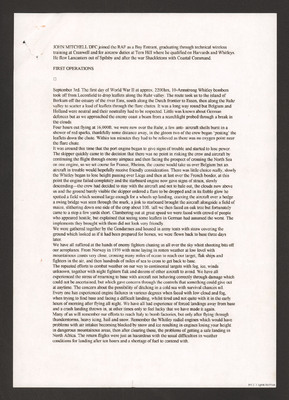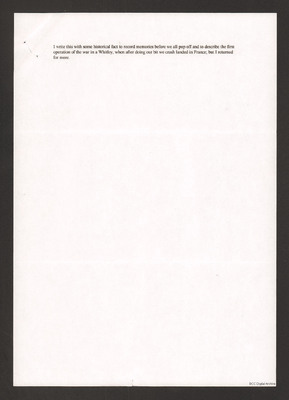First Operation
Title
First Operation
Description
John Mitchell describes events during his first operation to drop leaflets on the Rhur. After engine failure they force crash landed in a field in France. They were gathered by French Gendarmes and flown back to England three days later. In addition adds some recollections of problems and worries while carrying out attacks on Norway.
Creator
Temporal Coverage
Language
Format
Two page printed document
Publisher
Rights
This content is available under a CC BY-NC 4.0 International license (Creative Commons Attribution-NonCommercial 4.0). It has been published ‘as is’ and may contain inaccuracies or culturally inappropriate references that do not necessarily reflect the official policy or position of the University of Lincoln or the International Bomber Command Centre. For more information, visit https://creativecommons.org/licenses/by-nc/4.0/ and https://ibccdigitalarchive.lincoln.ac.uk/omeka/legal.
Contributor
Identifier
MMitchellJEF550261-160125-02
Transcription
JOHN MITCHELL DFC joined the RAF as a Boy Entrant, graduating through technical wireless
training at Cranwell and for aircrew duties at Tern Hill where he qualified on Harvards and Whitlcys.
He flew Lancasters out of Spilsby and after the war Shackletons with Coastal Command.
FIRST OPERATIONS
September 3rd. The first day of World War II at approx. 2200hrs, l O-Armstrong Whitley bombers
took off from Leconfield to drop leaflets along the Ruhr valley. The route took us to the island of
Borkum off the estuary of the river Ems, south along the Dutch frontier to Essen, then along the Ruhr
valley to scatter a load of leaflets through the flare chutes. It was a long way round but Belgium and
Holland were neutral and their neutrality had to be respected. Little was known about German
defences but as we approached the enemy coast a beam from a searchlight probed through a break in
the clouds.
Four hours out flying at 16,OOOft. we were now over the Ruhr. a few anti- aircraft shells burst in a
shower of red sparks. thankfully some distance away. in the gloom two of the crew began 'posting' the
leaflets down the chute. Within ten minutes they had to be relieved as there was no oxygen point near
the flare chute.
It was around this time that the port engine began to give signs of trouble and started to lose power.
The skipper quickly came to the decision that there was no point in risking the crew and aircraft by
continuing the flight through enemy airspace and then facing the prospect of crossing the North Sea
on one engine. so we set course for France, Rheims. the course would take us over Belgium but an
aircraft in trouble would hopefully receive friendly consideration. There was little choice really. slowly
the Whitley began to lose height passing over Liege and then at last over the French border, at this
point the engine failed completely and the starboard engine now gave signs of strain, slowly
descending-the crew had decided to stay with the aircraft and not to bale out, the clouds now above
us and the ground barely visible the skipper ordered a flare to be dropped and in its feeble glow he
spotted a field which seemed large enough for a wheels up landing, coaxing the aircraft over a hedge
a swing bridge was seen through the murk, a jink to starboard brought the aircraft alongside a field of
maize, slithering down one side of the crop about 10ft. tall we then faced an oak tree but fortunately
came to a stop a few yards short. Clambering out at great speed we were faced with crowd of people
who appeared hostile. but explained that seeing some leaflets in German had assumed the worst. The
implements they brought with them did not look very friendly.
We were gathered together by the Gendarmes and housed in army tents with straw covering the
ground which looked as if it had been prepared for horses. we were flown back to base three days
later.
We have an suffered at the hands of enemy fighters chasing us all over the sky whist shooting bits off
our aeroplanes. From Norway in 1939 with mine laying in rotten weather at low level with
mountainous coasts very close. crossing many miles of ocean to reach our target, flak ships and
fighters in the air. and then hundreds of miles of sea to cross to get back to base.
The repeated efforts to combat weather on our way to continental targets with fog, ice. winds
unknown, together with night fighters flak and dozens of other aircraft to avoid. We have all
experienced the stress of returning to base with aircraft not behaving correctly through damage which
could not be ascertained. but which gave concern through the controls that something could give out
at anytime. The concern about the possibility of ditching in a cold sea with survival chances nil.
Every one has experienced engine failures in various degrees when faced with low cloud and fog,
when trying to find base and facing a difficult landing, whilst tired and not quite with it in the early
hours of morning after flying all night. We have all had experience of forced landings away from base
and a crash landing thrown in, at other times only to feel lucky that wc have made it again.
Many of us will remember our efforts to reach Italy to bomb factories, but only after flying through
thunderstorms, heavy icing. hail and snow. Remember the Whitley radial engines which would have
problems with air intakes becoming blocked by snow and ice resulting in engines losing your height
in dangerous mountainous areas, then after clearing these, the problems of getting a safe landing in
North Africa. The return flights were just as hazardous with the usual difficulties in weather
conditions for landing after ten hours and a shortage of fuel to contend with.
[page break]
I write this with some historical fact to record memories before we all pop off and to describe the first operation of the war in a Whitley, when after doing our bit we crash landed in France, but I returned for more.
training at Cranwell and for aircrew duties at Tern Hill where he qualified on Harvards and Whitlcys.
He flew Lancasters out of Spilsby and after the war Shackletons with Coastal Command.
FIRST OPERATIONS
September 3rd. The first day of World War II at approx. 2200hrs, l O-Armstrong Whitley bombers
took off from Leconfield to drop leaflets along the Ruhr valley. The route took us to the island of
Borkum off the estuary of the river Ems, south along the Dutch frontier to Essen, then along the Ruhr
valley to scatter a load of leaflets through the flare chutes. It was a long way round but Belgium and
Holland were neutral and their neutrality had to be respected. Little was known about German
defences but as we approached the enemy coast a beam from a searchlight probed through a break in
the clouds.
Four hours out flying at 16,OOOft. we were now over the Ruhr. a few anti- aircraft shells burst in a
shower of red sparks. thankfully some distance away. in the gloom two of the crew began 'posting' the
leaflets down the chute. Within ten minutes they had to be relieved as there was no oxygen point near
the flare chute.
It was around this time that the port engine began to give signs of trouble and started to lose power.
The skipper quickly came to the decision that there was no point in risking the crew and aircraft by
continuing the flight through enemy airspace and then facing the prospect of crossing the North Sea
on one engine. so we set course for France, Rheims. the course would take us over Belgium but an
aircraft in trouble would hopefully receive friendly consideration. There was little choice really. slowly
the Whitley began to lose height passing over Liege and then at last over the French border, at this
point the engine failed completely and the starboard engine now gave signs of strain, slowly
descending-the crew had decided to stay with the aircraft and not to bale out, the clouds now above
us and the ground barely visible the skipper ordered a flare to be dropped and in its feeble glow he
spotted a field which seemed large enough for a wheels up landing, coaxing the aircraft over a hedge
a swing bridge was seen through the murk, a jink to starboard brought the aircraft alongside a field of
maize, slithering down one side of the crop about 10ft. tall we then faced an oak tree but fortunately
came to a stop a few yards short. Clambering out at great speed we were faced with crowd of people
who appeared hostile. but explained that seeing some leaflets in German had assumed the worst. The
implements they brought with them did not look very friendly.
We were gathered together by the Gendarmes and housed in army tents with straw covering the
ground which looked as if it had been prepared for horses. we were flown back to base three days
later.
We have an suffered at the hands of enemy fighters chasing us all over the sky whist shooting bits off
our aeroplanes. From Norway in 1939 with mine laying in rotten weather at low level with
mountainous coasts very close. crossing many miles of ocean to reach our target, flak ships and
fighters in the air. and then hundreds of miles of sea to cross to get back to base.
The repeated efforts to combat weather on our way to continental targets with fog, ice. winds
unknown, together with night fighters flak and dozens of other aircraft to avoid. We have all
experienced the stress of returning to base with aircraft not behaving correctly through damage which
could not be ascertained. but which gave concern through the controls that something could give out
at anytime. The concern about the possibility of ditching in a cold sea with survival chances nil.
Every one has experienced engine failures in various degrees when faced with low cloud and fog,
when trying to find base and facing a difficult landing, whilst tired and not quite with it in the early
hours of morning after flying all night. We have all had experience of forced landings away from base
and a crash landing thrown in, at other times only to feel lucky that wc have made it again.
Many of us will remember our efforts to reach Italy to bomb factories, but only after flying through
thunderstorms, heavy icing. hail and snow. Remember the Whitley radial engines which would have
problems with air intakes becoming blocked by snow and ice resulting in engines losing your height
in dangerous mountainous areas, then after clearing these, the problems of getting a safe landing in
North Africa. The return flights were just as hazardous with the usual difficulties in weather
conditions for landing after ten hours and a shortage of fuel to contend with.
[page break]
I write this with some historical fact to record memories before we all pop off and to describe the first operation of the war in a Whitley, when after doing our bit we crash landed in France, but I returned for more.
Collection
Citation
J E F Mitchell, “First Operation,” IBCC Digital Archive, accessed November 5, 2024, https://ibccdigitalarchive.lincoln.ac.uk/omeka/collections/document/27549.
Item Relations
This item has no relations.


